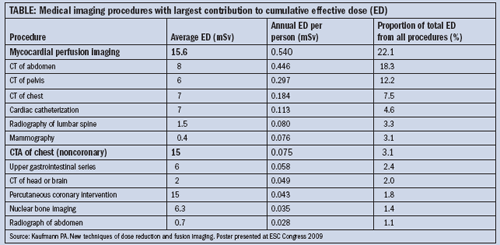Researchers grapple with dose reduction methods in cardiac CT
Electrocardiogram-gated tube modulation is essential to lower radiation dose in fusion imaging.
Electrocardiogram-gated tube modulation is essential to lower radiation dose in fusion imaging. Prospective triggering can also lead to massive dose reductions, and it works for all scanners and can be combined with nuclear perfusion imaging.
These are the main recommendations of Prof. Philipp Kaufmann, director of cardiac imaging at Zurich University Hospital. He also told delegates at the European Society of Cardiology congress, held in Barcelona in late August, that low-dose hybrid imaging is now feasible with modern protocols and new detector technology for myocardial perfusion imaging systems. High-pitch spiral acquisition is very promising, but is bound to dualsource CT.
“The two main problems with CT coronary angiography (CTCA) are image quality and effective radiation dose,” he said. “Scanner design should be compact, with multiple detectors, a focus on the heart, and no detector motion.”
It important to be aware of three CT dose parameters, he said.

The first is volume CT dose index (CTDIvol), which takes into account the average radiation dose in all three directions (i.e., x-, y-, and z-directions). It is based on a standardized phantom and is directly related to the overlap between adjacent slices, which varies by slice thickness and the distance between the acquired slices. Distance increases in a spiral scanning mode by increasing pitch.
Dose length product (DLP) reflects the total energy absorbed by the patient, and represents the z-directional integration of the CTDIvol. Therefore, the length of the scan has to be kept as short as possible, Kaufmann said.
Dose eff, on the other hand, describes the risk of partial, nonuniform body exposure relative to an equivalent whole-body exposure, and best classifies the risk of biological injuries. It is estimated by multiplying DLP by a conversion factor of mSv/mG x cm for chest CT. Often 0.017 is used, but 0.014 can be applied, which will result in a dose reduction of up to 19%, he said.
Kaufmann and his colleagues at Zurich have found that low-dose CCTA by ECG-gating is feasible in a large population, but it requires careful patient preparation, and heart rate control is crucial. For patients with a heart rate of 62 beats per minute or less, diagnostic image quality can be obtained at a very low radiation dose (2.2 ± 0.8 mSv).
“Single heart beat, dual-source CCTA may be an effective means for high-quality images at very low radiation dose in the future,” Dr. Bernhard Bischoff, a radiologist at Munich’s German Heart Center, told ESC delegates. “Due to the second x-ray acquisition, dual-source CT may allow for cardiac CT data acquisition with very fast table movement, at a pitch value greater than 3, during a single heart beat, with the potential for radiation dose reduction.”
However, vendors must make improvements in this technology to avoid early diastole for data acquisition, which will reduce the frequency of motion artifacts for the assessment of the coronary arteries, he said.
The use of a SnapShot Pulse (SSP) technique can result in a 77% reduction of effective radiation dose in CCTA, without a significant loss of image quality, according to research from Argentina presented at the ESC congress.

In a prospective study involving 60 patients (55 men, five women; average age: 55 years), a team from the Corrientes Institute of Cardiology compared 64-slice CT using SSP for half the sample and the conventional technique for the other half. Two blinded readers assessed subjective image quality for coronary artery segments by using transverse sections and maximum intensity projections. The effective dose was calculated on the basis of DLP and CTDIvol.
CT examinations in the SSP mode were successful in 29 patients. In one patient, the examination had to be repeated because of poor diagnostic quality due to increased heart rate. The average heart rate was 56 (6 SD) beats per minute (range: 42 to 65). There was no significant difference in the subjective image quality. The mean effective dose for the SSP technique was 5.43 mSv ± 0.39, compared with 16.44 mSv ± 0.97 for the conventional method.
New Collaboration Offers Promise of Automating Prior Authorizations in Radiology with AI
March 26th 2025In addition to a variety of tools to promote radiology workflow efficiencies, the integration of the Gravity AI tools into the PowerServer RIS platform may reduce time-consuming prior authorizations to minutes for completion.
The Reading Room: Artificial Intelligence: What RSNA 2020 Offered, and What 2021 Could Bring
December 5th 2020Nina Kottler, M.D., chief medical officer of AI at Radiology Partners, discusses, during RSNA 2020, what new developments the annual meeting provided about these technologies, sessions to access, and what to expect in the coming year.